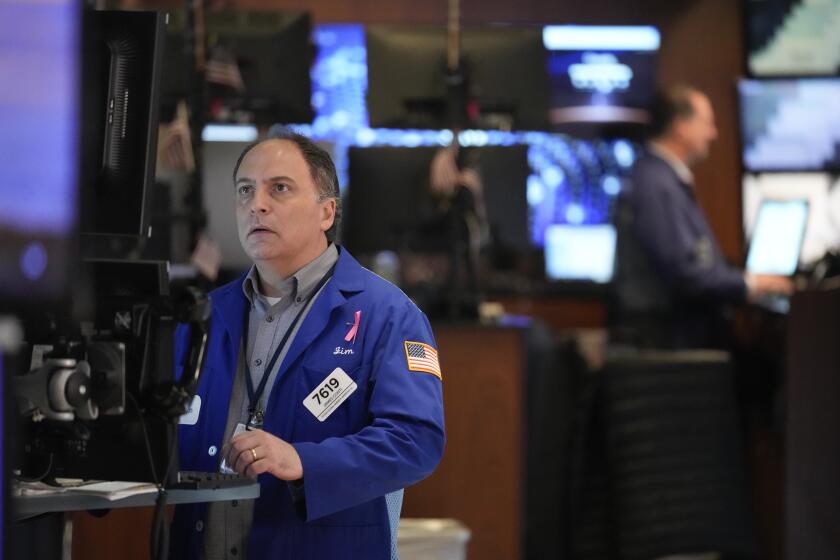Wachovia’s savings program ups the ante
Spend your way to savings. That’s the concept behind a new program called Way2Save that was launched last month by Wachovia Bank.
It is being touted by some as one of the most innovative bank products in decades. And it has triggered criticism by others as a clever ruse to drive up overdraft fees.
Way2Save is an automatic savings program that is triggered by debit card transactions. Every time someone who has signed up for the program makes a debit card purchase, that person’s checking account is debited for that cost plus $1.
The additional dollar is deposited in a savings account linked to the debit card account. The savings account offers a generous interest rate -- an annualized 5% for the first year -- plus the ability to earn bonuses on money left in the savings account for a year. These $1 savings contributions also are made each time a consumer pays a bill online or through an automatic debit.
The program is a bit like one launched by Bank of America just over two years ago, which rounds up debit card purchases to the nearest dollar, putting the extra amount into savings.
However, Wachovia says its nationwide program will allow customers to save far more than Bank of America’s Keep the Change product. That’s because the account holder is contributing more per transaction and can add optional contributions, and because the return on the savings account is high compared with other short-term interest rates.
“We want to help people save and help them to save enough to really matter -- enough for a car repair or a medical bill,” said Kathryn Black, savings director at Charlotte, N.C.-based Wachovia. “If somebody is really taking advantage of the program, just by doing things that they do every day, they are going to be paying themselves first.”
However, some consumer advocates suspect an ulterior motive.
“Banks know that the more that you use your debit card, the more likely you are to overdraw your account, particularly if you are a low-balance account holder,” said Rhea L. Serna, senior policy advocate with the California Reinvestment Coalition, an advocacy group for low-income people. “The amount that they’ll pay you in interest and bonuses is really minuscule in comparison to the overdraft fees.”
Serna was the author of a report late last year that detailed how bank policies “confuse and mislead” customers into putting their checking accounts into the red -- at an exorbitant cost -- with often incidental debit card transactions.
The public has been led to believe that using a debit card is like paying cash and the transaction won’t go through unless there’s money in your account, Serna said. But that’s not true anymore. Instead, banks commonly allow debit transactions to go through, without warning the account holder that the transaction will put them into overdraft and probably trigger a fee of $30 to $35.
“I will have consumers tell me that they used their debit card three times in one day and they got hit with three $30 overdraft charges,” said Gail Hillebrand, senior attorney with Consumers Union in San Francisco.
“You naturally assume that the bank will not let a bad charge go through. But they let it go through and then hit you with a big fee. Most of us, if warned, would make the rational choice of skipping whatever it is that we were going to buy that day to avoid the $30 fee,” she added. “But we’re not given the warning.”
Wachovia executives said their bank-wide overdraft rules were under review. The company also said it had designed several safeguards in its Way2Save program to avoid the rare or random overdraft.
Specifically, the $1 transfer payments will not be made on any day in which they’d send the account into overdraft, Black said.
Moreover, the savings account will automatically be used as a back-up for overdraft protection on the customer’s linked checking account, she said.
In other words, if a debit transaction exceeds a checking account’s balance, the bank will automatically cover it with money from the customer’s savings account at no additional charge. Account holders would be nicked with overdraft fees only if both accounts run dry.
Meanwhile, Wachovia isn’t exaggerating when it says its savings incentives are generous, said Stephen Brobeck, executive director of Consumer Federation of America.
In today’s market, it’s rare to find a 5% interest rate on savings. In addition, the bank will pay account holders a year-end “bonus” of up to another 5% of the contributions that have remained in the account for a year or more. In all, that gives the potential for a 10% annual return, he said.
But the 5% rate is guaranteed only for the first year. After that, Wachovia will drop the rate on the account to 2%, a rate closer to market averages for bank savings accounts.
Still, Brobeck called the program “the best product I’ve seen offered by a bank.” He said it could “help moderate-income households start to save.”
He cautioned, however, that people need to be mindful of their debit card purchases; some of those transactions don’t get recorded immediately, which can give cardholders a false sense of security. Consequently, people who frequently use a debit card need to leave some cushion in their account to ensure that their account doesn’t become overdrawn.
Even so, anyone who can manage a checking account ought to consider this one, Brobeck said.
“It helps you save through very generous yields and reduces the chance that you’ll overdraw your checking account with the buffer of the savings account,” he said. “This checking account offers an attractive way to build emergency savings. That can serve as the basis of a long-term, effective wealth building strategy.”
--






